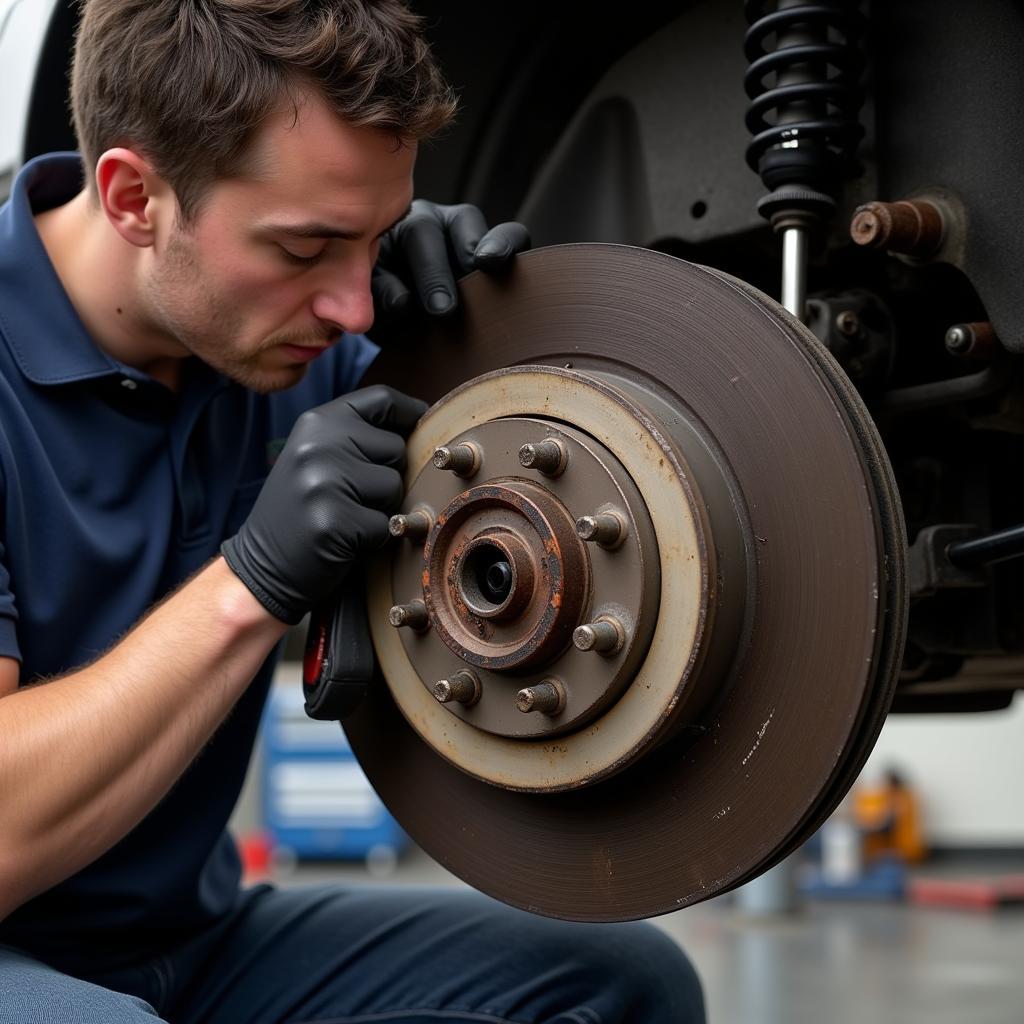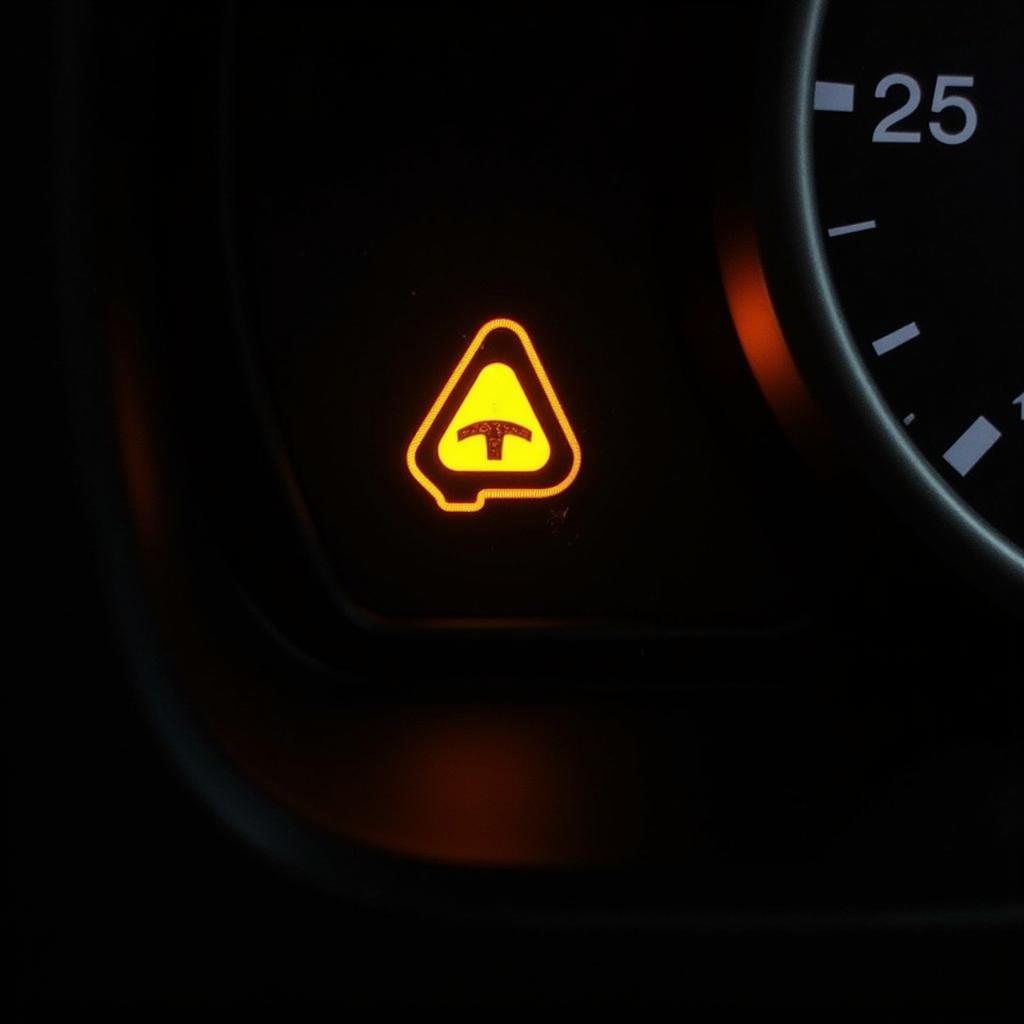The brake pad warning light on your Skoda dashboard is a crucial safety feature designed to alert you to potential issues with your braking system. Ignoring this warning could lead to reduced braking performance and even dangerous driving situations. This article provides a comprehensive guide to understanding and addressing the Skoda brake pad warning light.
Understanding Your Skoda’s Brake System and Warning Light
Your Skoda’s braking system utilizes brake pads to clamp down on the brake rotors, creating friction that slows and stops the vehicle. These pads wear down over time due to the heat and friction generated during braking. The brake pad warning light illuminates when the brake pad material reaches a critically low level, indicating the need for immediate inspection and likely replacement.
Common Causes of the Skoda Brake Pad Warning Light
While worn brake pads are the most common culprit, several other factors can trigger the brake pad warning light on your Skoda:
- Worn brake pad sensor: Most modern Skodas have electronic sensors embedded within the brake pads. When the pads wear thin, the sensor contacts the brake rotor, triggering the warning light.
- Faulty brake pad sensor: Like any electrical component, these sensors can malfunction, illuminating the warning light even with sufficient pad material remaining.
- Low brake fluid level: Low brake fluid is often a sign of a leak in your braking system, which can impact braking performance and trigger the warning light.
- Worn brake rotors: Severely worn rotors can affect the contact between the brake pads and rotor surface, potentially activating the warning light.
- Issues with the braking system wiring: Damaged or corroded wires within the braking system can disrupt the signal from the sensor, leading to an inaccurate warning.
 Skoda Brake Pad Sensor
Skoda Brake Pad Sensor
What to Do When Your Skoda Brake Pad Warning Light Comes On
If the brake pad warning light illuminates on your dashboard, follow these steps:
- Safely pull over: Find a safe location to stop your vehicle as soon as possible. Continuing to drive with compromised brakes can be extremely dangerous.
- Check your brake fluid level: Locate the brake fluid reservoir under the hood (refer to your owner’s manual). If the fluid level is low, it could indicate a leak in the system, requiring immediate attention from a qualified mechanic.
- Inspect your brake pads: If it is safe to do so, you can visually inspect your brake pads through the wheel spokes. Look for a significant decrease in pad thickness. However, it is important to note that a visual inspection might not always reveal the full extent of the wear.
- Avoid heavy braking: Minimize harsh braking to prevent further strain on your braking system.
- Schedule an inspection: Even if you do not notice significant issues during your initial assessment, it is crucial to schedule an inspection with a qualified mechanic immediately. They have the expertise and tools to diagnose the problem accurately and recommend necessary repairs.
 Skoda Brake Pad Replacement
Skoda Brake Pad Replacement
The Importance of Timely Brake Pad Replacement
Timely brake pad replacement is vital for maintaining optimal braking performance and ensuring your safety on the road. Ignoring the warning light and delaying replacement can lead to:
- Reduced braking efficiency: Worn brake pads take longer to stop your vehicle, increasing the stopping distance and the risk of accidents.
- Damage to brake rotors: Driving with worn pads can score and damage the brake rotors, requiring costly repairs or even replacements.
- Complete brake failure: In extreme cases, driving with severely worn brake pads can lead to complete brake failure, putting you and others at serious risk.
Preventing Future Brake Pad Issues
While brake pad wear is inevitable, you can take steps to maximize their lifespan and prevent premature wear:
- Adopt smooth braking habits: Avoid harsh braking whenever possible. Gradual braking reduces wear and tear on the pads and rotors.
- Lighten your load: Avoid carrying unnecessary weight in your vehicle, as a heavy load puts more strain on the braking system.
- Regular brake inspections: Include brake inspections as part of your routine vehicle maintenance schedule.
 Skoda Brake System Inspection
Skoda Brake System Inspection
Conclusion
The brake pad warning light in your Skoda should never be ignored. Promptly addressing the underlying issue is essential for maintaining your safety and preventing costly repairs. Regular maintenance and timely replacements are crucial for optimal braking system performance and a safe driving experience.
Frequently Asked Questions
Q: Can I drive with the brake pad warning light on?
A: While you might be able to drive a short distance, it is strongly advised against continuing to drive with the brake pad warning light illuminated. This light indicates a potential issue with your braking system that requires immediate attention.
Q: How often should I replace my Skoda’s brake pads?
A: The lifespan of brake pads varies depending on driving habits and conditions. As a general guideline, it is recommended to have your brake pads inspected every 12,000 miles and replaced when necessary.
Q: How much does it cost to replace brake pads on a Skoda?
A: The cost of brake pad replacement can vary depending on the model of your Skoda, the type of brake pads used, and labor costs in your area. Consult a qualified mechanic for an accurate estimate.
Q: Can I replace my Skoda’s brake pads myself?
A: Brake pad replacement requires some mechanical knowledge and tools. If you are comfortable working on your vehicle, you can find resources online or in repair manuals. However, it is always recommended to have brake work performed by a qualified mechanic to ensure proper installation and safety.
Q: What are the symptoms of worn brake pads besides the warning light?
A: Other indicators of worn brake pads can include a squealing or grinding noise when braking, vibrations in the brake pedal, and a longer stopping distance. If you experience any of these symptoms, have your brakes inspected immediately.

